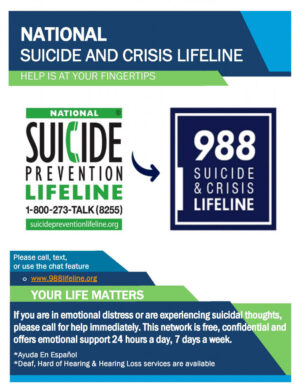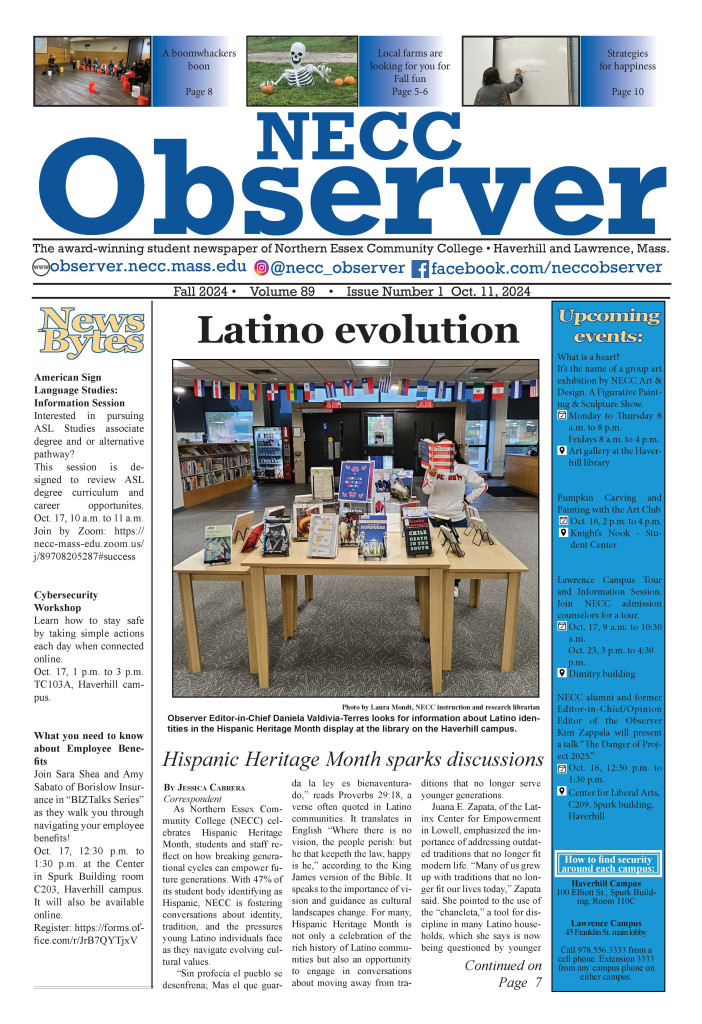
Students in Dr. Doris Buckley’s Introduction to Psychology online class were given a service-learning project this semester to promote the new 988 Mental Health Hotline. One of the topics students always want to learn about when taking Introduction to Psychology is mental disorders. They want to know how they can support their friends and families. The reality is that Introduction to Psychology has many topics to cover and mental disorders is only one small part of the course content.
Students were given a lot of freedom with this assignment as long as it met the goal of promoting the hotline. They were also required to write a reflection on their project. The outcome of their projects was so impressive! Projects included videos to share on social media, letters, and posters to put around campus to name a few.
One of the letters was written specifically for the Observer and is included here. This edition of the Observer also includes a poster that a student created. (Editor’s note: The Observer plans to feature more of the posters as public service announcements next semester.)
The holidays are a time of year when there are plenty of celebrations. However, for many it is also a difficult time for a myriad of reasons.
I hope that the amazing projects created by my students will bring awareness to our community but more importantly encourage individuals to reach out for help if needed.
988 for mental health
By Lindsey Latchford
Suicide is the second leading cause of death in children. Read that again. It is the second leading cause of death in children aged 10-24. The Suicide and Crisis Lifeline is now offering easily accessible help that is avalible 24 hours a day, 7 days a week.
During 2020, Congress designated the 988 dialing code to replace the National Suicide Prevention Lifeline as an attempt to transform America’s crisis care system. Making the process to call for help easier couldn’t have come at a better time for our youth. Covid was at its peak and our youth were tremendously suffering right under our noses.
After talking to my own children and their friends about the impact of Covid, a few common complexities continued to surface; loneliness, isolation, and fear. We, their parents and the government created a world that was nothing like the world they knew.
We isolated them from their friends and family, stopped them from attending their sports and activities, and what seems to be the most impactful of them all, taught them from zoom calls. We had created all this change to protect their health and just hoped that they’d come out okay on the other side.
Of course, some seemed just fine. They were able to adapt and “go with the flow,” but many suffered deep sadness, anxiety, fear, and other social complications. As a result, when it was time to enter back into the “normal life,” or close to it rather, they were significantly behind in society. Having two children of my own that now require medications for crippling anxiety, I observed that not only has the need for selective serotonin reuptake inhibitors (SSRI’s) increased, but the absence of psychiatric assistance is also a substantial issue.
Implementing 988 as a resource for anyone suffering from thoughts of suicide has made it much easier for those feeling those desperate feelings to seek help. The website itself is easy to navigate, organizing specific care from youth to veterans and anyone in between. All it takes is one simple click and you can discover the 988 line.
The site ensures confidentiality, offers both call and text options, as well as clearly explaining what will happen if or when you call the line. It is made very clear that they are non-judgmental and ready to help, making note that any problem is worth calling about. This prevents those little problems from piling up, which can have an affect just as bad as one big problem would have.
The Suicide and Crisis Lifeline site also shares valuable information for friends or family members who are worried about loved ones. The site lists warning signs, risk factors, and steps to take if someone you know is potentially suffering from suicidal thoughts, or any mental health issue. Not only does it tell you how to help your loved ones, but it tells you how to help yourself if there is too much weight on your shoulders.
There is no denying that our world is suffering from a mental health crisis and having resources like this one are vital for us to overcome it. Whether you or someone you know are experiencing these thoughts, there is something you can do to help. Having the option to call 988 is a great way to begin that healing process.

